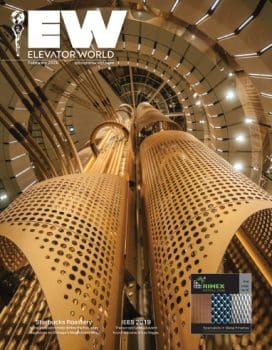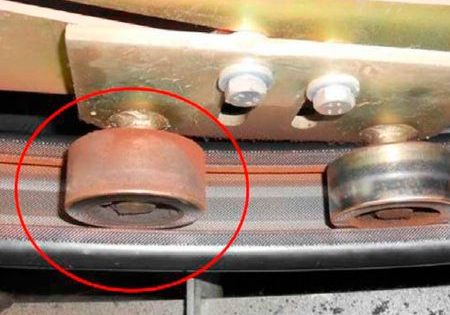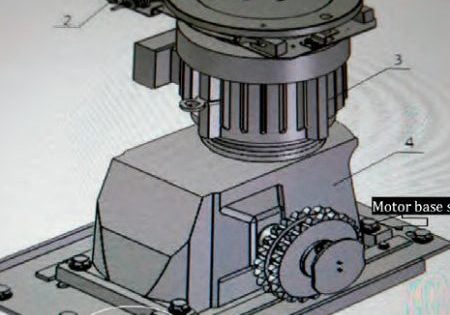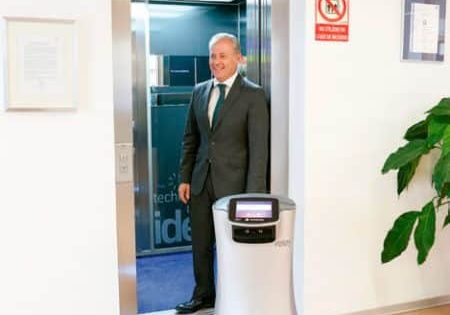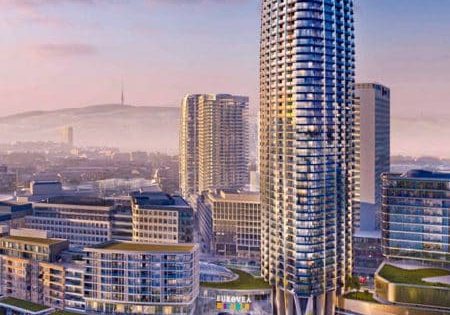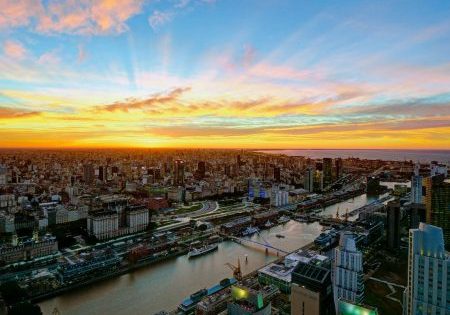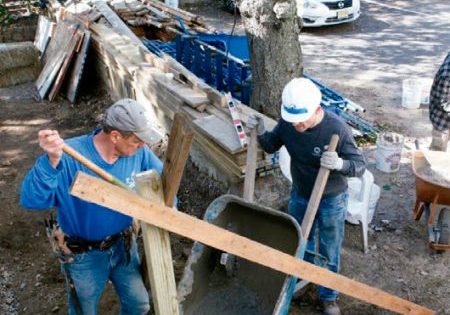“A Spectacular Ride”
Feb 1, 2020

Mitsubishi Electric spiral escalator, the first in the U.S. Midwest, helps distinguish the largest Starbucks in the world on Chicago’s Magnificent Mile.
photos courtesy of Starbucks
Mitsubishi Electric’s Inazawa Works factory in Japan manufactured the components of the 15-ft, 4-in.-tall spiral escalator serving the largest Starbucks retail store in the world — the five-story, 35,000-ft2 Chicago Starbucks Reserve Roastery on the city’s Magnificent Mile at Michigan Avenue. Work began on the single spiral unit in March 2018 before the components arrived onsite.
Mitsubishi Electric installation teams then got to work assembling the impressive system, a process that took approximately four months; that’s not even counting the time devoted to work by the local and factory engineering teams. Mitsubishi Electric U.S. Eastern Region Director Mike Eden estimated the project had been in the works for at least three years. “Starbucks wanted something that would stand out and be impressive,” he says.
Starbucks got what it wanted in terms of “impressive.” The conveyance, the first of its kind in the U.S. Midwest, makes a grand statement.During the November 15, 2019, opening, Gordon Segal, the retired Crate & Barrel founder who owns the property — the retailer’s former flagship store — praised the building’s transformation into a Starbucks, stating:
“It is really beyond my expectations. It is very beautiful, very Scandinavian in feeling. We put in a circular escalator to provide a spectacular ride up to the second floor. And, as you go up to the third and fourth floors, it becomes more and more exciting. I’m so very pleased with the way it turned out.”[1]
Segal and Starbucks CEO Howard Schultz are longtime colleagues and friends whose connection dates back to the late 1980s when Crate & Barrel was building its iconic store. Segal recalls that, at the time, real estate agents approached him about a “new coffee concept out of Seattle” wanting to lease a 2,000-ft2 space on the ground floor. “I said, ‘Well, that’s great, but no, I can’t lease them 2,000 ft2 because the whole first floor is only 6,000 ft2.’”[1] Segal recalls:
“I remember that opening. The store was gorgeous, business was nonstop, and from then on, it was terrific. The store made Crate & Barrel’s national reputation probably more than any other thing we had ever done. Even though we had been in business for many years, that store put us on a different level. Little did I realize then, it’s almost what Starbucks is doing with the roasteries. Today, there are thousands of very good smaller Starbucks [shops] but only a few majestic roasteries around the world that are going to educate people about coffee.”[1]
Segal and Schultz reconnected a few years ago to discuss the possibility of the Crate & Barrel (which closed in early 2018) being turned into a Starbucks. Another Chicago Starbucks location is nearby, and the plan was to close it and establish a roastery. For both men, the idea was a no- brainer.
The first Starbucks Reserve Roastery opened in Seattle where the company began. The next ones opened in Shanghai, Milan, Tokyo and NYC. Now, there is the Chicago location, “the most vertical of the roasteries.”[2] Observing that the two words “look up” perhaps best encapsulate the Chicago design, Starbucks said it is aimed at drawing the eye in and up.
The spiral escalator is a key part of that upward feel and among the favorite design features of Jill Enomoto, the Starbucks vice president who led the design. It takes visitors through “multiple levels of coffee wonderland,” allowing them to better experience “the light, the streaks of green, the multistory, bronze-colored coffee cask, the hustle and bustle of Starbucks employees and customers moving through [the multiple levels.]” Elaborating on the spiral system, she says:
“[It] is designed to take visitors on a 360˚ tour with coffee roasting, brewing and scooping on one side and a view out the curved-glass windows to Chicago’s Magnificent Mile on the other. I think some people will come just to ride the curved escalator. It’s such a different thing. You feel like a kid again. It’s been fun watching people’s faces on their way up.”[2]
At Starbucks in Chicago, the spiral system replaced a standard bank of escalators. In its product brochure, Mitsubishi Electric says:
“Symbolizing and accentuating spaciousness, spiral escalators dramatically portray an increased field of vision. The principal objective of the layout is to create a space where people can stop, rest and communicate, such as a lobby, lounge or public area.”
At Starbucks, the spiral escalator system is part of “an immersive experience dedicated to roasting and brewing small-batch Starbucks Reserve coffee from around the world.” It winds around a giant, 56-ft-tall steel cask that is, essentially, a “silo of coffee beans” and provides visitors with a unique sensory spectacle. A golden roaster prepares 25 lb of beans at a time, which are funneled into the cask after being roasted. From the spiral escalator, visitors can watch the beans travel from the cask up to the Experimental Coffee Bar on the third floor through a series of glass, air-powered tubes.[2]
Mitsubishi Electric U.S. Senior Marketing Manager Margie Harvey, who, at the time of this writing, was preparing to travel from Cypress, California, to Chicago to see the system in operation, says, “We weren’t able to talk about it much over the last few years until it actually went live, so we are so thrilled!”
I think some people will come just to ride the curved escalator. It’s such a different thing. You feel like a kid again.
— Starbucks Vice President Jill Enomoto
The third-floor roastery bar is not your ordinary bar, but rather, an expansive, light-filled space with menus sure to receive a thumbs-up from even the most discerning gastronomy snobs. Here, one can order flights of whiskey-barrel-aged Starbucks ReserveTM coffee creations prepared in creative ways. Many are infused with nitrogen — a process that adds to the creaminess — and some contain high-end spirits.
Mitsubishi Electric’s newest spiral escalator was customized by Starbucks with “coffee-bean brown” handrails rather than standard black, Eden shared. Because of the roastery’s design, traditional escalator equipment would not have fit, he says.
SpiralEscalatorsMultiply in U.S.
The next-closest Mitsubishi Electric spiral escalators are approximately 790 mi. away in NYC at the Bloomberg headquarters and approximately 980 mi. away at the Encore Boston Harbor casino resort. They are examples of the manufacturer’s corner and entrance installations, respectively. At Bloomberg, the escalator is situated along the lobby wall, freeing up the central floor area for visitors.
At Encore Boston Harbor, a pair of curved escalators flank a giant ceramic urn art piece by Viola Frey. The venue is renowned for its art, including the urn (a similar piece in the series was sold by Christies Auction House for US$50,000)[3] and a Jeff Koons Popeye sculpture that cost a whopping US$28 million.[4] Spiral escalators, meanwhile, cost considerably more than standard units.
Mitsubishi Electric’s spiral escalators are primarily in Asia, but they are multiplying in the U.S. Two of the escalators went live at the Seminole Hard Rock Hotel & Casino in Tampa in July 2019. Not surprisingly, there are also spiral escalators in Las Vegas, at Wynn Las Vegas and The Forum Shops at Caesars Palace,® which in December 2019 hosted the International Elevator and Escalator Symposium dinner, organized by Liftinstituut and ELEVATOR WORLD.
References
[1] Segal, Gordon. “How a Chance Meeting Paved the Way for the Chicago Roastery,” starbucks.com, November 13, 2019.
[2] Warwick, Jennifer. “New Starbucks Reserve Roastery: A Love Letter to Chicago,” starbucks.com, November 13, 2019.
[3] christies.com
Get more of Elevator World. Sign up for our free e-newsletter.

